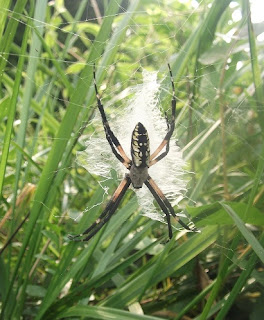For nearly one hundred years a beautiful house lived in a beautiful garden on the corner of 5th and Polk.
After a devastating fire in 2010, the house-less lot sat for a couple years with a "For Sale" sign in the planting verge out front. The owner, who lost everything in the fire, moved out of state. The lot filled up with trash. Weeds ran riot in the raised beds, fast-growing invasive trees and shrubs shot for the sky, and the meticulously cultivated formal garden went totally bananas.
Even so, elements of that formal garden remained: Raised beds, stone walls, and brick pathways. Pink and white dogwoods, enormous azaleas, a coral bark Japanese maple, fruit-bearing peach trees, a weeping magnolia, roses, ornamental cherries, holly trees, too many ornamental grasses and vines to name, and a small hardy orange tree growing in the middle of a bamboo grove.
"No hunting, trapping, fishing or trespassing! " read the signs on the gates. Still, ladies of the night, and sometimes ladies of the mid-afternoon, took their Johns to the bamboo grove. The lot became a place to misbehave.
Sometimes I put on my heavy gloves and picked up a token bag of trash around the picket fence while my children climbed trees and picked flowers. My small house with its small yard is just down the street from the lot. In fact, when I first bought my house, I would show off the house and garden at the corner of 5th and Polk to visitors.
"See? That's a nice house," I'd say, trying to impress my visitors with the worthiness of my mostly working-class neighborhood.
I didn't know yet that some of the worst-looking houses held the best neighbors.
Today, the long double lot, with a downward slope facing north away from a busy street, still has trees and bushes growing against the fence surrounding the property. Of course, there is an empty place in the middle where the house used to be. Standing in this private meadow one late-summer day I felt an stab of desire for the land. I fall into crushes with land like this every so often, the desire to own it and protect it and keep it exactly the way it is, except maybe make it a little bit better. Usually, the land is way out of my price range, but this lot was almost doable.
Some of the lot was clay and mud, but some of it was tall grass, like a real meadow, and it was full of birds.
We knew the owner slightly, and when we called him on the phone he gave us a very nice deal. I think he was happy to sell it, finally. We borrowed money from our parents, collected our tax return, cashed in some savings, and bought the lot.
We hauled out a ton of trash, cleared the fallen limbs, and pulled up piles of privet (a lot remains still.) We had an inaugural bonfire, and mixed the ashes into the clay. We spread mulch, sowed seeds of grasses and flowers, and planted two native trees (a persimmon and a paw paw.) We removed the signs reading, "No hunting, trapping, fishing, or trespassing."
The Butterfly Meadow is a tiny urban wilderness, inspired and informed by the Knoxville Botanical Garden Butterfly Meadow. Its purpose is to attract wildlife, especially butterflies and birds, through special plantings and lightly managing the existing trees and other plants.
We hope that mowed paths and clearings will encourage visitors, especially children in the neighborhood, to explore, become comfortable with plants and animals, and learn to trust themselves in a place that is tangly and alive, yet surrounded by asphalt on three sides. The Parkridge Butterfly Meadow is a work in progress, but we are happy with it even now. It is not perfect, it's not meant to be. It's a different kind of nature than that found in a city-maintained park or playground. We expect to still be picking up candy wrappers and Kool-aid bottles, and we don't expect everyone who visits to be on their best behavior. But we do believe that beautiful places make the world better.
We believe these words of John Muir are true:
"Everybody needs beauty as well as bread, places to play in and pray in, where nature may heal and give strength to body and soul."






























